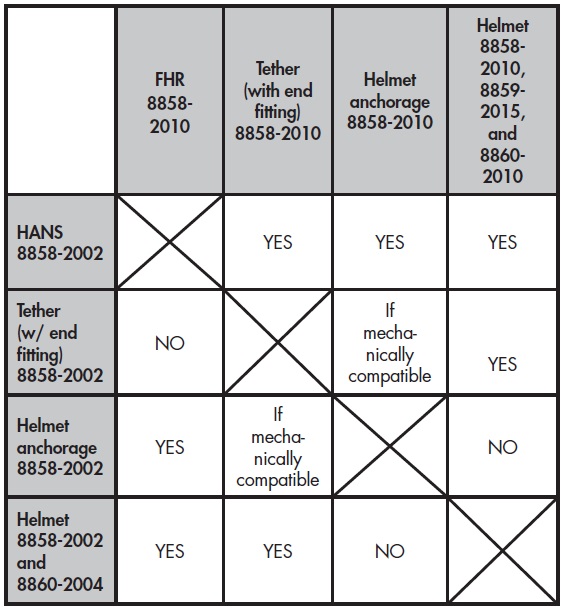(Znajduje się tutaj przetłumaczony rozdział 3 zał.L FIA)
Rozdział III – wyposażenie kierowcy
Art. 1 Kaski
Art. 2 Odzież ognioodporna
Art. 3 System ochrony głowy (FHR)
Art. 4 Pasy bezpieczeństwa
ROZDZIAŁ III – WYPOSAŻENIE KIEROWCY
1. Kaski
1.1 Standardy
Wszyscy kierowcy ścigający się w wyścigach torowych , wyścigach górskich lub rajdach, włączonych w kalendarz FIA, muszą nosić homologowane kaski zgodne ze standardami wymienionymi na liście technicznej N° 25 FIA.
Jeśli stosowanie systemu ochrony głowy (FHR – Frontal Head Restraint) zgodny z artykułem 3 poniżej, jest obowiązkowe, dopuszcza się tylko kaski zgodne ze standardami FIA:
- 8858 (Technical List N°41)
- 8860 (Technical List N°33)
- 8859 (Technical List N°49)
Kaski homologowane zgodnie ze standardem 8860 FIA – (Technical List N°33), wymagane są dla kierowców:
- the Formula One World Championship
- the FIA World Rally Championship, if listed as priority 1
- the WTCC
- the WEC
- the FIA World Rallycross Championship
- the FIA GT World Cup
- the international series for F2, GP2, GP3 and F3 cars.
Wszyscy kierowcy biorący udział w FIA Formuła 1 muszą używać F1 Visor Reinforcement Panel (szyba kasku wzmocniona) dla kasków FIA 8860.
Jest zalecane, aby wszyscy kierowcy w WRC i World Rallycross Championship i w tych międzynarodowych seriach, w których stosuje się techniczne regulacje wraz z wymaganiami testów zderzeniowych dla Formuły 1 , F3 i F3000 nosili kaski homologowane zgodnie ze standardem FIA 8860.
1.2 Conditions of use
Drivers of open cockpit cars must wear full-face helmets, of which
the chin bar is an integral part of the helmet structure and is tested
to an FIA-approved standard. This measure is recommended for
historic open cockpit cars and Autocross SuperBuggy, Buggy1600
and Junior Buggy.
Any tear-offs attached to visors may not be thrown onto the track
or the pit lane.
Full visors fitted on the full face helmets which are listed in Technical
Lists N°33, 41 and 49 must be labelled with an FIA sticker. The
implementation dates are:
• Visors manufactured as from 01.01.2016 must have an FIA
sticker.
• Visors manufactured before 31.12.2015 do not have to be
labelled with an FIA sticker and may still be used without one.
Drivers and co-drivers in closed cockpit cars who wear full-face
helmets must be able to pass the following test(1), in order to
ensure that appropriate access to the airway of an injured driver
is possible:
– the driver is to be seated in his car, with helmet and FIAapproved
head restraint in place and attached and safety
harness buckled.
– with the help of two rescuers, the chief medical officer of the
competition (or, if present, the FIA medical delegate), must be
able to remove the helmet with the driver’s head maintained
permanently in a neutral position.
If this is impossible, the driver will be required to wear an openface
helmet.
Drivers must contact the FIA medical delegate or the Chief Medical
Officer in order to carry out the above test before the start of the
event.
(1)for historic cars, compliance is recommended.
1.3 Modifications
No helmet may be modified from its specification as
manufactured, except in compliance with instructions approved by
the manufacturer and one of the FIA-listed standards organisations
which certified the model concerned. Any other modification will
render the helmet unacceptable for the requirements of the present
Article 1.
1.4 Maximum weight and communications systems
– Helmet weights may be checked at any time during a
competition and must not exceed 1800 g for a full-face type
or 1600 g for an open-face type, including all accessories and
attachments.
– Helmet-mounted radio speakers are prohibited in all circuit
and hill-climb competitions, excluding Rallycross and
Autocross competitions (earplug-type transducers are allowed).
Applications for waivers, on medical grounds only, may be
made through the driver’s ASN’s Medical Commission. The
fitting of microphones may be done only in respect of Article 1.3
above.
1.5 Decoration
Paint can react with helmet shell material and affect its protective
capacity; therefore, where a manufacturer provides guidelines or
restrictions on the painting or decoration of helmets, these must be
followed, using only paint specified by them (air drying acrylic,
polyurethane enamel or others) and preferably a painter having
their approval. This is particularly important for injection-moulded
shells, which are not usually suitable for painting.
The shell being painted should be efficiently masked, as paint
penetrating the interior can affect the performance of the helmet
liner.
Paints requiring heat curing should not be used and any process
should not exceed the maximum temperature of conditioning of the
helmet in the standard to which it is approved.
The manufacturer’s instructions should also be consulted for any
considerations on the use of stickers and transfers.
2. Flame-resistant clothing
In circuit competitions, hill-climbs, special stages of rallies and
selective sections of cross-country competitions entered on the
International Sporting Calendar, all drivers and co-drivers must
wear overalls as well as gloves (optional for co-drivers), long
underwear, a balaclava, socks and shoes homologated to the FIA
8856-2000 standard (Technical List N°27).
Users must ensure that garments are not too tight, as this reduces
the level of protection.
Embroidery sewn directly onto the overalls shall be stitched onto
the outermost layer only, for better heat insulation. Backing material
of badges and thread used for affixing them to the overalls must be
flameproof. Printing on drivers’ clothing must be carried out only
by the manufacturer of the product and must be flameproof and in
conformity with the standard ISO 15025. It must not reduce heat
transmission performance as defined in Article 8.2 (see Appendix
1 of the FIA 8856-2000 Standard for detailed requirements and
instructions for use).
Drivers of single-seater cars in races with standing starts must
wear gloves in a high-visibility colour which contrasts with the
predominant colour of the car, so that the driver can clearly draw
the attention of the race starter in case of difficulties.
Substances which may circulate in any cooling system worn by a
driver are restricted to water, or air at atmospheric pressure. Water
systems must not require the saturation of a garment in order to
function.
For competitions taking place in extreme heat, it is recommended
that a cooling system be used (connected, for example, to the
underwear designed for that purpose and homologated according
to the FIA 8856-2000 standard).
Exceptionally, driver cooling vests which are not FIA-homologated
may be worn but shall be in addition to the mandatory
homologated underwear. They must include a base garment
certified and labelled to ISO 15025; any tubing must be certified
and labelled to ISO 17493 and must not be in contact with the
driver’s skin, and any connection to an on-board system must
comply with Article 5.8.6 of the FIA 8856-2000 standard.
3. Frontal Head Restraint (FHR)
3.1 The wearing in an international competition of any device
intended to protect the head or neck and attached to the helmet
is prohibited, unless the device has been homologated according
to the FIA 8858 standard. Homologated FHR systems are listed in
the FIA Technical List N° 29. The minimum reclined HANS collar
angle shall be 60° from the horizontal.
Any padding used between the driver and the HANS® yoke must
not be more than 15 mm thick when the driver is seated in the car
fully equipped with the harness tightened. The padding must be
covered by a flameproof material in conformity with the standard
ISO 15025 and the padding must not be wider than 8 mm on
each side of the HANS® yoke.
FIA-approved FHR systems must be worn by drivers and co-drivers
in all International competitions, with the following exceptions or
provisions:
The wearing of an FIA-approved FHR system is:
a) mandatory for Formula 1 cars of period G and onwards except
in case of written dispensation obtained from the FIA Safety
Commission;
b) recommended for other historic cars;
c) mandatory, in off-road, for all FIA European Championship
competitions except for Autocross SuperBuggy, Buggy1600
and JuniorBuggy for which it is strongly recommended, with
compatible helmets;
Important: see the end of the Appendix for the changes which will
enter into force on 1 January 2017
d) not mandatory for the following categories of alternative
energy vehicles: I, III, IIIA, IV, V Electric Karts, VII and VIII;
e) recommended for alternative energy vehicles in categories
II, V Cars and VI with a technical passport issued before
01.01.2006.
For other cars in which for technical reasons it is impracticable
to fit the FIA-approved FHR, it will be possible to apply to the FIA
Safety Commission for a waiver.
3.2 Conditions of use
FHR systems must be worn only with FIA-approved items according
to the following chart:

(2) Mandatory wearing of helmets in each championship according to
Article 1.1 above.
Tether system
(tether, tether end fitting and
helmet anchorage)
- FIA 8858 (Technical List Nº 29)
For more details when the device used is the HANS®, the “Guide
for the Use of HANS® in International Motor Sport”, published
by the FIA Institute for Motor Sport Safety, can be found on www.
fia.com, under the heading FIA Sport – Regulations – Drivers’
Equipment.
3.3 Compatibility and permitted use of items approved to the FIA
8858-2002, 8858-2010, 8859-2015, 8860-2004 and 8860-
2010 standards.

The FIA 8860-2004 (Advanced helmets) and FIA 8858-2002
(FHR systems and compatible helmets) standards were updated
in 2010. Both the original and revised versions, together with FIA
standard 8859-2015 (Premium Helmet), remain valid when used
as shown on the chart above.
4. Safety Belts
Drivers must be properly restrained in their seat by safety belts in
conformity with the specifications of Appendix J for the vehicle
concerned, at all times during a competition when it is mobile on a
circuit, pit lane, special stage or competition course.


